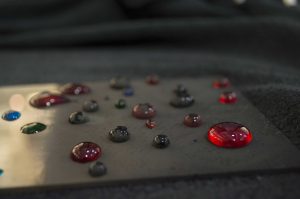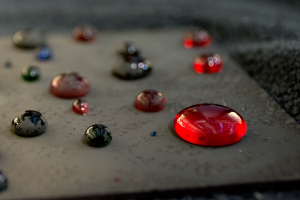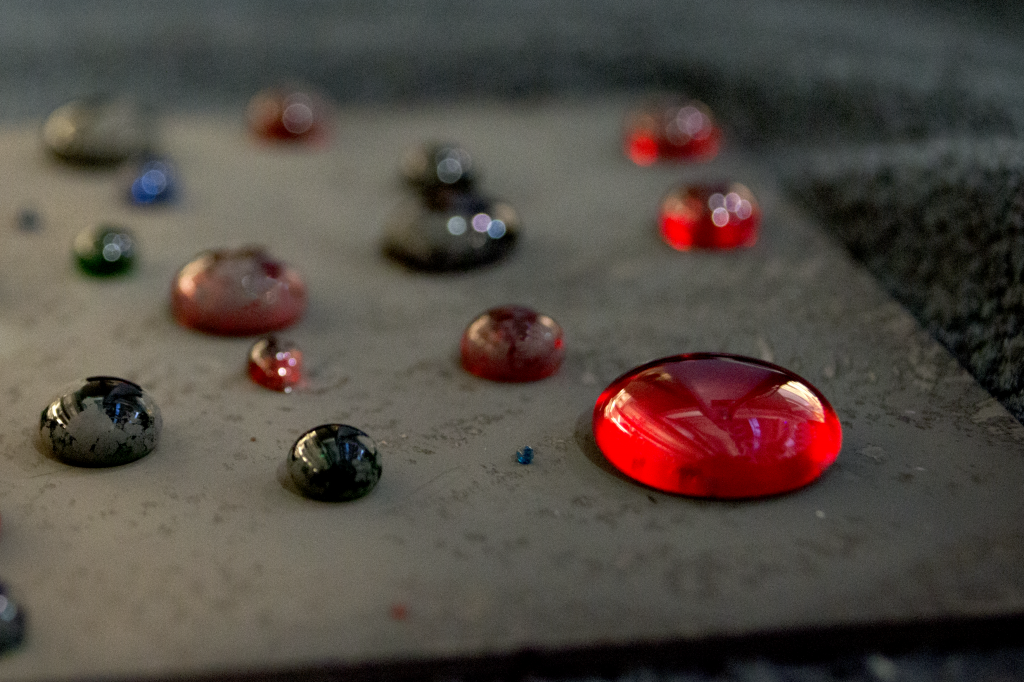We created a “superhydrophobic” surface on which we placed several colorful droplets of water.
Team Members: Katie Gresh and David Leng
Introduction
Flow visualization give insight to how flow phenomena operates in our surroundings. For this assignment, teams were tasked with photographing these phenomena. Team 2 worked with superhydrophobic surfaces. These surfaces allow water droplets to have high contact angles, resulting in spherical or semi-spherical droplets. Using a homemade surface, the team dropped several dyed water droplets on the surface and photographed the results.
Flow Apparatus
In order to create a superhydrophobic surface, few items are needed. The team used isopropyl alcohol (90%), a small dish (ceramic), a lighter, a piece of glass, and a ceramic plate (Figure 1). The process does involve a flame, so safety glasses are recommended. Fill the dish with a small amount of isopropyl alcohol and light this on fire. Holding the glass from the bottom, wave it over the flame to begin coating it in the soot from the flame. The glass used was fairly thin, so to avoid cracking it the team held the glass over the flame for 1 min and let it cool for 10 min. This cycle was repeated until the glass was black (about 4-5 min over the flame). During the cooling cycles, the glass was placed on the ceramic plate to avoid damaging the table the setup was resting on. Finally, the glass was cooled to room temperature (about 15 min). The coated glass is now a superhydrophobic surface. This process is a summary of a video found on YouTube made by Robin Deits [Ref 4].
For this particular experiment, the glass was a regular 8”x10” glass cover for a picture frame. The area coated in soot is roughly half of the area of the glass. The water droplets vary in size and were randomly distributed all along the glass. The water was mixed with various colors of food dye to produce the colorful array of droplets.
Fluid Physics
The following is taken directly from team member Katie Gresh’s paper explaining the physics of hydrophobic surfaces. Figures can be referenced in her paper. References in excerpt correspond to references at the end of the paper.
“The contact angle (θ) on a wetted surface is given by Young’s Equation (1805) as [Ref 1]:
Cos θ = (γSV– γSL) / γLV
γSV = Solid Surface Energy
γSL = Solid-Liquid Interfacial Energy
γLV = Liquid Surface Tension

Figure 1: Contact Angles – Formed by sessile liquid drops on a smooth homogenous solid surface [Ref 2]
The contact angle (θ) on a rough surface is defined by Wenzel’s Equation where roughness is determined by the roughness factor and has a value greater than one [Ref 3]:
r = Arough / Aflat
r = Roughness Factor
Arough = Area of the rough surface
Aflat = Area of the flat surface
The contact angle (θ) on a rough surface is given by Wenzel’s Equation [Ref 4]:
r Cos θ = r (γSV– γSL) / γLV
γSV = Solid Surface Energy
γSL = Solid-Liquid Interfacial Energy
γLV = Liquid Surface Tension
A hydrophobic surface exhibits and fluid interaction with a contact angle greater than 90 degrees [Ref 2]. Superhydrophobic surfaces exhibit contact angles greater than 150 degrees with water, as shown in Figure 5 [Ref 2]. Fully wetted surfaces exhibit a contact angle of 0 degrees with water and show a puddle, as shown in Figure 2 [Ref 2].”
The estimated contact angles for the chosen image vary from approximately 140 deg to 160 deg. Hydrophobic surfaces are characterized by the contact angle of the droplets. The high contact angles as seen in the images from our team occur when the surface is roughened on a nanoscale. The roughness acts as pillars that reduce the amount of solid that the water is in contact with and traps air between the “pillars” [Ref 5]. In this case, the ultrafine soot particles act as pillars for the water to rest on. Some of the droplets appear to be more spherical than others. This is likely due to the varying film of soot underneath the water. Some of the droplets bounced or rolled when they were placed on the glass and picked up some of the soot. This decreased the amount of soot beneath the droplets, resulting in lower contact angles.
Photographic Technique
The camera used in this experiment was a Nikon D3200 DSLR camera. The specifications of the images are shown below.
| F.O.V. | 5”-6” |
| Distance: Obj to Lens | 12” |
| Focal Length | 32 mm |
| F-stop | f/4.8 |
| Shutter Speed | 1/25 sec |
| ISO | 1600 |
| Original Dimensions | 6016×4000 px |
The lighting used was fluorescent lighting from the lab in which the experiment took place. For post processing, some light spots were edited out. Adjustments were made to the contrast, lighting, and exposure settings. All post processing was completed in Photoshop. The original and edited images are seen below in Figures 2 and 3, respectively.


Figure 2: Original, uneditied image Figure 3: Final, edited image
Conclusion
Overall, I am happy with the outcome of the team’s experiment. Superhydrophobic surfaces are an area of research that would be interesting to explore. I wish we had played with different fluids on the surface. I also wish I had taken more photographs of uncolored water for a more natural looking image. Finally, I wish we had done the experiment in a place in which we could control the lighting. I like the FOV of the image I chose. I like that most of the droplets are softened and the largest is in focus. It is very interesting to me that contact angles can be estimated right off of the image. I would be interested in exploring this phenomenon further.


25 Comments. Leave new
Very interesting, this sounded like a pretty easy and affordable way to make a superhydrophobic surface! There were a couple seminars a few weeks ago that talked about similar experimentation which got me interested in the topic, but they made it sound pretty difficult to make superhydrophobic surfaces. I really like your artistic effects also, with one large red droplet (which looks like a bead from Mancala) and smaller black droplets with the matte isopropyl soot on them. Great idea and incredible job!
Nice focus on the large red drop on the right. The depth of field works well also in my opinion. The colors of the dye in the water is so surreal. It almost looks like melted marbles.
Nice vibrant colors in this image. I like the focus and how well shaped the droplets are.
I especially appreciate the technique for creating the hydrophobic surface. Also the focus on the Red Drop is really crisp and professional. If I had one recommendation is would be to have the hydro phobic surface a little larger so that the background is consistent.
I really like the focus on the image and some of the reflections on the surface of the liquid. Great work capturing this photo!
The water droplets almost look like aquarium marbles. The idea to use a hydrophobic is incredibly interesting. The photo might benefit from being slightly brighter, but otherwise looks great!
I understand and like the out of focus part in the back, however I think there is too much that is out of focus and takes away from the overall image. The front droplets are very clean and have a nice reflection of light.
I like the method you used to get the hydrophobic surface, and the several different colored and sized droplets. I also think the depth of field was used really well to have particles blurred in the back with focus in front.
Really cool photo. Love how crisp the photo is and the color variations in the droplets. Love how the shape and size of droplets is varied. The bright colors of droplets are a perfect contrast to greys in the photo.
1. Artistically great image with good contrast between the red and soot.
2. The fluid physics are well shown.
3. The photographic technique is well done.
Cool image! I wish there was more depth of field but it is a stunning image. Great colors lighting and focus.
The process behind making the glass is really interesting. i like how all the different colors of the droplets add to the photo
It’s interesting how you decided to focus on only a few droplets to highlight the image. I like how vibrant the colors look in the image.
Cool idea for a fluids image. Interesting setup. Like how the focus is on the big droplet and the rest are slightly out of focus.
This photo is really nice, clean and crisp. I like the focus, the droplets look like glass. The process of making the hydrophobic surface sounds fascinating, it makes me want to try this at home!
Art: The color contrast between the background and the water droplets is very dramatic.
Flow: The flow is quickly understandable and recognized.
Photographic technique: The depth of field is well done with the focus on the biggest droplet being sharp and the farther away droplets being slightly out of focus is well done.
Really cool experiment, the water focus is crisp and the reflections add another level of mystery. The water drops on the left that aren’t in focus add a nice depth.
Cool how every droplet is a different size. Nice reflections off the droplets. I find it nice that you focused the closest droplets and blurred the others more as you moved to the background.
Fascinating methods of creating this photo! Having multiple different colored droplets makes the photo very pleasing to the eye.
Awesome technique to create hydrophobic surface. Great snap of water droplets, I really like the color element in each one.
Art: Really awesome that the water droplets are different colors
Flow: Very creative and interesting technique
Technique: I really like the focus on the bottom right droplet and the gradual blurring to the background
Possibly crop out the sides a little bit, the carpet? off to the side is a bit distracting from the image. Colors are beautiful, well focused image on the largest drop. The texture of the silt on the glass adds a nice effect.
Interesting science experiment! I love how the use of hydrophobic material. It clearly shows the flow.
– Very clean image no distracting elements, the blur of the carpeted area adds a bit of opposing texture to the well shaped drops.
– I really like the colors and decreasing focus of the other drops in the background.
The narrow depth of field, differing colors, distinct drops, and extreme shine on the drops all make this look like CGI and almost not even real. I really like this shot a lot, especially the way you used different colors for all the drops. I wish you had a bigger hydrophobic surface to work with, as that would eliminate the somewhat distracting background.